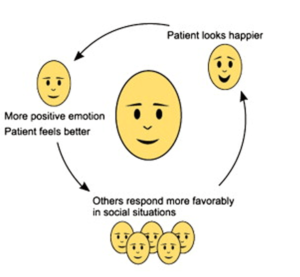
The Surprising Effect of Botox on Emotional Processing

What is Botox?
Botulinum toxin, often known as botulinum neurotoxin (BoNT) or Botox (the commercial version of BoNT), is becoming increasingly popular as time passes. Botulinum toxin has gained popularity for its significance and usage for medical and cosmetic purposes. However, a new study on the “facial feedback hypothesis using Botox injections” discovered more evidence for Botox usage than just being seen as a beauty enhancer.
A study conducted into the “Facial Feedback Hypothesis” by a small team of researchers from the University of California, Irvine, has revealed that receiving Botox injections in the forehead can change how the brain processes information.
How does this work?

The Facial Feedback Hypothesis proposes that, when we see happy or angry faces on one’s faces, we contract or flex the relevant muscles replicating the expression seen in order to stimulate the expression.
The idea of “facial feedback” was originally suggested by Charles Darwin, who suggested that physiological changes caused by emotion were not just a consequence of that emotion but had a direct impact on the psychological experience of that emotion.

This is an involuntary action that causes our facial muscles to mimic the expression on one’s faces in order to send signals to our brains. This is not merely done to interpret others’ emotions and expressions but rather to experience the feelings ourselves.
The Study
The study was conducted by a small group of researchers from the University of California, Irvine, or UCI. The participants consisted of ten healthy, right-handed females, ranging in age from 33 to 40 years old. The participants had no prior history of using botulinum toxin.
The goal of the study was to understand the effects of BoNTA on the natural workings of the brain at the time of processing emotional faces. The first MRI examination took place 4–14 days before the onabotA injection, and the second was taken 13–23 days after the injection.
The onabotA injections were administered to participants in the glabellar region; the glabella is a skeletal region located between the eyebrow and the nose.
In the post-injection visit, all participants noticed physical changes in sensation and difficulty pulling their eyebrows together, which indicates the influence of the onabotA injections.
Pictures of angry and happy facial expressions were shown to participants, using specified time periods between and for each picture. To guarantee that participants were judging the emotional expression of the face, participants used a button box during each trial to indicate whether they believed each of the faces was pleasant or unpleasant.
The results of the research found that there was evidence of changes when seeing happy and angry faces after the administration of Botox injections. The amygdala, which is the centre of our brain responsible for emotional processing, showed signs of change when exposed to happy and angry faces.
The constraint caused by the movement of facial muscles through Botox injections hampers the way in which the brain processes emotional faces. The paralysis caused by the Botox injection in the muscle movements alters the communication between the face, the amygdala, and the fusiform gyrus (the fusiform gyrus is the area in the inferior temporal cortex that is important for object and face identification, as well as facial emotion recognition).
If Botox may change the path of emotional messages, the natural question is whether it can be utilised for psychological treatment.The answer is yes; the inability to portray emotions such as frowning will hinder the emotional signal sent to the brain for processing, which can be a course of treatment for depression. In the FDA Adverse Event Reporting System (FAERS) database of the United States.
It was stated that people treated with BoNTs had a substantially lower rate of depression compared to a control group of patients who received any medication for depression and compared to those who received other treatments for a variety of conditions such as cosmetic, chronic migraine, and spasticity. Although this appears to be a possibly safe and effective method for depression control, further study is needed before recognising it as the most viable option for the treatment of depression.







